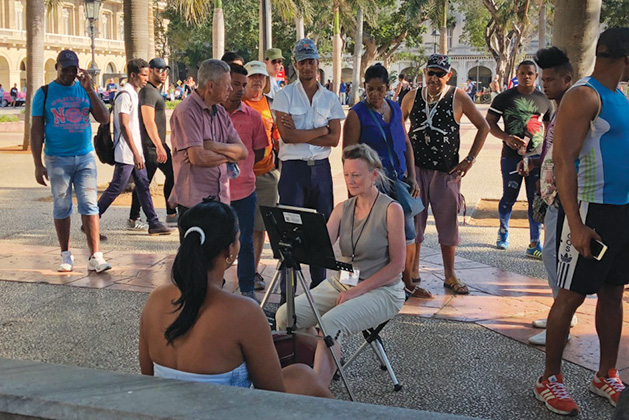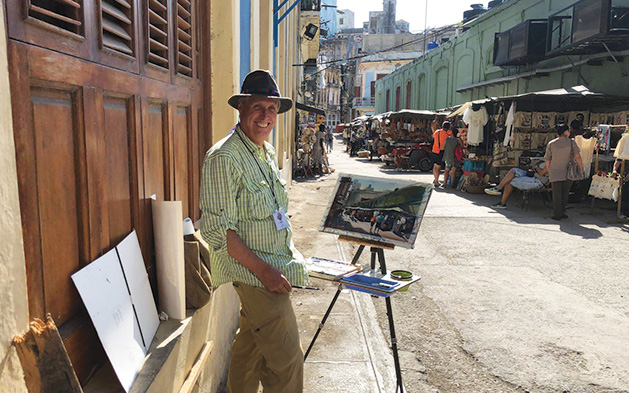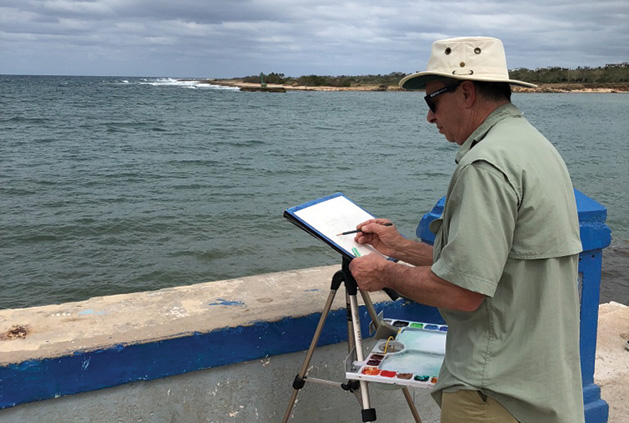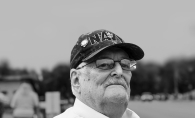
You could say the people of Cuba were drawn to Deb Zeller.
During a week last March, Zeller sat in a shady spot for many hours in Old Havana, sketching face after face on an easel. Though the Victoria-based painter and sculptor doesn’t speak Spanish, it was typical for her to be surrounded by the locals watching her work or waiting their turn to model. What was her secret? After she finished a drawing, Zeller let her subject choose a “small gift” from the suitcase near her feet. Half of it was stuffed with art supplies, the rest with reading glasses, makeup, nail polish, hair scrunchies and gardening gloves she brought from Minnesota.
“A photographer friend had been there a year earlier, and she told me the best thing you can do to pay someone for sitting for a portrait is to give them things they can’t get in Cuba,” she explains. “They were very grateful.”
Zeller’s popularity among the locals was also a testament to her talent for drawing lifelike portraits. Her last sketch was of a cigar-smoking, beret-wearing character named Fidel. When she finished, Zeller showed it to him and “this tough, gruff guy started crying,” she says. “We sort of touched a piece of his soul.”

Painting Cuba
Zeller and four others from Minnesota traveled for the first time to Cuba as part of a trip sponsored by PleinAir Magazine. In all, 50 artists participated. The magazine—named for the French term for painting outdoors—offers artist retreats and exotic painting trips, and this was the second trip to Cuba.
Joining Zeller were Kathy Howard, a semi-retired patent attorney who summers in Greenwood; Jack Liebo, an Edina artist and retired doctor; Jim Turner, a Mound artist and retired anesthesiologist; and Zeller’s husband Steve, winemaker at Parley Lake Winery in Waconia and director of global real estate at Donaldson Co.
Their paintings from the trip were on display last fall during an art show titled Viva Cuba—The People of Cuba at The Gallery at Zeller Studio in Hopkins. Zeller, a self-taught portrait artist and sculptor, opened her studio in 2016.
During the trip, artists spent most of their time meandering through historic Old Havana looking for just the right setting to capture. Inspiration wasn’t hard to find amid a colorful splash of once glorious but now decaying architecture and a nostalgic parade of 1950s American cars dotting the streets.
“Those elaborate, crumbling buildings make a terrific backdrop,” Liebo says. “It’s a great place to paint.”
Zeller, Liebo and Turner are all longtime artists with a passion for, as Liebo says, “starting with a white page and coming up with something that makes me happy.” Howard and Steve Zeller are beginners; to go on the trip, you had to paint. Steve—an avid traveler who never painted before the trip—took a lesson from Turner to prepare.
“It was a completely different thing that I got myself into, and it was great,” says Howard, who mostly went along to see Cuba, though she did complete a few sketches.
All five know each other through painting or longtime friendships. Liebo actually met Turner while both were in medical school at the University of Minnesota. About 15 years ago, Turner—who remembered Liebo had been an artist in college—suggested the two take a watercolor workshop together.
“And we’ve been painting watercolors ever since,” says Liebo, who majored in studio art before turning to medicine.
Deb Zeller and Turner called the trip creating art on the streets of Cuba a “journey of a lifetime.” Besides Zeller, who admits she doesn’t do so well drawing buildings, the others focused on sketching the urban landscapes.
“We had breakfast and out we went,” Turner says. “We’d paint all day and then go somewhere fabulous for dinner. I spent every part of every day painting and taking pictures (like other painters did), so I could do more paintings when I got home.”

Seeing Cuba
Walking in Havana is like taking a time machine back nearly 60 years when Fidel Castro seized power of Cuba. The beautiful old buildings remain, but not much is maintained. Holes in steps and roofs are common.
“It’s going to change; everything changes,” Turner says. “But it has not changed much since 1959.”
Steve Zeller saw that firsthand, in a row house about 10 blocks from their hotel that caught his eye. He plopped down his art supplies on a dilapidated 1957 Chevy, using it as an easel, and started to paint.
“I build buildings for a living, so I obviously focused on the architecture,” he says.
A man soon drove up in a scooter and parked in front of the building. It turned out he lived there with his mother, and the two invited Steve into their house.
Inside, he discovered only one of the rooms—a bedroom—had a ceiling. “They pointed, all excited,” says Steve, who does not speak Spanish. “I look around the corner, and there is a brand new toilet sitting out in the open. No ceiling above, no door, but they were proud that they had a real toilet.”
Before he left, Steve had them both sign his picture. “The story part of this is probably more important than the painting,” he says.
Some of the artists rented classic cars and had them parked in front of buildings, to set a scene. “Everywhere you look there are these old preserved American cars that you never see in America, and many are being driven as cabs,” Liebo says. “It’s their livelihood. Their father took care of it and passed it down to them.”
The artists found that the average person in communist Cuba lives a rather austere, simple life. “They are well educated, they have pretty good health care,” Turner says. “But from a material standpoint, they have very little.”
Tourists eat in the most beautiful hotels in Cuba, while the locals try to get by with rations of beans and rice, pork and some chicken.
“You’re on the Caribbean and seafood should be plentiful, but there are no boats,” Steve says. “The boats are in Florida or have been confiscated. Otherwise, people will leave.”
One of Turner’s paintings explores that theme. He drew it from a photograph of a tugboat and a couple container ships he took out a bus window in a Cuban fishing village. Those were the only boats he saw on the trip. “I put those figures in who weren’t there because I can imagine when you’re trapped on this island with no way out how it would feel to walk by and look at ships that were leaving,” he says.
Steve would like to one day go back to see what progress has been made to improve the country’s infrastructure. “You know, in another 10 to 15 years as things presumably open up for Cuba, it’s going to start rising again,” Steve says.
Turner says the memories from the trip come alive every time he looks at one of his paintings. “That’s what I like about painting plein air,” he says. “If you sit down and look at something long enough and hard enough to make a painting of it, you’ll always remember the smells and the sounds and the conversations around you. It all becomes part of the image.”

About the artists
Deb Zeller, a Victoria painter and sculptor, is a retired mechanical engineer, who has always had a passion for art. After putting in 20 years in the corporate world, she saved enough money to realize her lifelong dream when she opened Zeller Studio in Hopkins more than two years ago. “When I was 13 years old, my parents scraped enough money together to buy me an oil painting set, and I thought I was the luckiest girl on earth,” she remembers. Not only does her studio feature the work of local artists, but she also provides figure and portrait study cooperatives, where artists can hone their skills drawing models.
Jack Liebo, a retired physician, creates pottery and paintings in his home studio in Edina. He majored in both studio art and pre-med while an undergraduate at the University of Minnesota. “I’m living the good life now because I have the time to do this,” he says. “And I have the ease of having a retirement account, so I can travel and paint.”
Jim Turner of Mound retired after many years as an anesthesiologist in January 2018. He paints 30 to 40 hours a week, relishing in the creative process after years of having to be so exacting as an anesthesiologist. “I’m not a professional. I sell paintings, but I don’t try to make a living at this, and I’m glad I don’t have to,” he says. “So, I paint for myself. This is what I love to do. I like to go someplace and paint what appeals to me. Somebody else likes it, that’s great, but the process is what I find fascinating.”
Steve Zeller never painted before the trip. Turner gave him a lesson, and his wife helped him with his color blending. When he isn’t traveling in his job as director of global real estate at Donaldson Company, he is the winemaker at Parley Lake Winery in Waconia, which the Zellers own with another couple.
Kathy Howard, a semi-retired patent attorney who spends her summers in Greenwood admits her participation in the Cuba trip was limited since she’s not an artist. She drew a couple of sketches in Cuba, but the highlight of the trip for her was spending a day rock climbing at Viñales Valley National Park.
Instagram: @pleinairmag
Facebook: Zeller Studio | Plein Air Magazine
Twitter: @PleinAirMag









